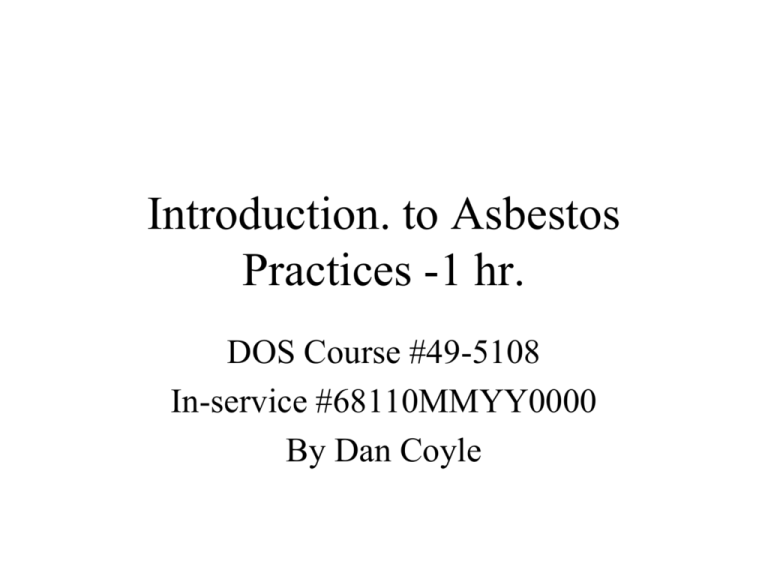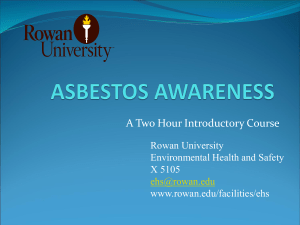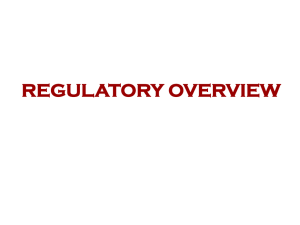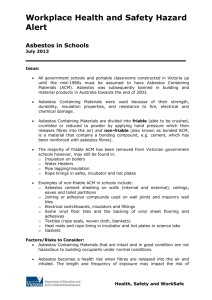Introduction to Asbestos Practices- 1 hour, 49-6410
advertisement

Introduction. to Asbestos Practices -1 hr. DOS Course #49-5108 In-service #68110MMYY0000 By Dan Coyle Registration Cards • • • • • • County Location Course # 49-5108 FDID& City Code # Completion Date MM-YY Instructor: blank County Code: relates to FDID Registration Cards (cont.) • • • • Instructor Code County Code In-service Number 681100MMYY0000 Contact • • • • • • • NYS Dept. of Labor DOSH-ACB, Room 202 450 S. Salina St. Syracuse 13202 (315) 479-3215 www.labor.state.ny.us, labor.ny.gov www.alternativemodelingsolution.com Talk Choices • One Hour general basics, code independent • Two Hour extreme work practices details – ICR56 Major CEO Points • Always Licensed Contractors & Certified People • Survey or ID Friable & Non-friable ACM’s • Notifications - Building, DOL, EPA • Clearance & Visual Inspection • Written Assurance of Removal Performed for Work Area & Associated ACM’s Talk Agenda • • • • • • I. Asbestos Background - preliminary II. Regulatory Jurisdictions – gov’t III. General Project Life Cycle - phases IV. Statutory Credentials - permits V. Project Oversight – who, what VI. Project Abatement Basics - jargon Talk Agenda (cont.) • VII. Common Abatement Methods – ACM types • VIII. Variances – alternatives, difficulties • IX. Enforcement – agencies, issues • X. Web Pages – more information • XI. Conclusion – good ideas • XII. Proposed ICR56 Revisions – ? I. Asbestos Background • • • • A Properties – why & what asbestos is B. Health concerns – damage & diseases C. Applications – materials & where found D. Concept of asbestos project – abatement A. Properties • Fibrous mineral small: micron size • Various types Canadian chrysotile, amosite, & others • Common & nice to use • Heat insulator • Material binder B. Adverse Health Effects • • • • • Lung Cancer & Smoking Risks Synergistic, multipied => X Mesothelioma of pleural lining – fatal Asbestosis (lung capacity)- chronic General Fibrosis (alveoli scarring)respirable dusts, not acute • Gastrointestinal problems & skin? C. Applications • Common in older (Thermal System Insulation) TSI’s, fireproofing • Common in older plasters, tiles • Common in built-in roofing, shingles • Common in newer glues, mastics, sealants • Many construction uses! Why Excessive Exposure Risks • Adverse Health Effects in Long Term 20 years + (smokers, contaminations?) • Common in Construction Practices • Exists in many places insulation, walls, flooring, ceilings, patches • Improper controls for exposure risks • Friable vs non-friable ACM’s ** breaking ACM Types • Asbestos Containing Materials • Friable: easily crumbled by hand- TSI’s, fireproofing, plasters, severely damaged • Non-friables: fibers encapsulated & difficult to break up, VAT, asphalt, organically bound • Cementatious can be pulverized easily D. Concept of Asbestos Project • • • • Inspect for damaged and undamaged ACM Survey- ACM’s discovered In conjunction w/ demolition or renovation Project management options of removal, repair, enclosure, or encapsulation • Project completion & clearance Abatement Options • • • • • • Removal – ACM’s all gone Enclosure – air tight construction around Encapsulation – surface or bridging All require same project procedures! Repair – substrate spot removal & sealant Operations & Maintenance – housekeeping, repairs Renovations • • • • • Survey for “Impacted Suspect Materials” Portions built before 01January1974 Employees to be Notified of ACM’s All Materials Presumed ACM’s & All Waste is assumed Regulated ACM (RACM) w/o survey Demolitions • New Definition Remove load bearing member? • Survey Required 5.1, p41; LL Section 241 Paragraph 10, built before 01 Jan. 1974 • CEO, ACB, & Site copies • Structurally unsound & Ag bldgs.-no survey • Abatement & Clearance Normally II. Jurisdictions • A. USEPA: Air pollutants, schools • B. OSHA: Industry, construction, etc. • C. NYSDEC: Solid Waste Facilities & Transporter Permits- transfer stations also • D. NYSDOL: Asbestos projects A. USEPA: 40CFR Part 763 AHERA: schools • Asbestos Hazard Emergency Response Act from Clean Air Act • Survey & test building interiors • Renovation surveys & management plans for response actions to maintain ACM’s AHERA (cont.) • Final air clearances for large scale / long duration projects in schools • NYS Education Dept. & DOH – enforcement agents • Compliance w/ OSHA, state abatement, & all applicable regulations USEPA: 40CFR Part 61 NESHAP: air quality • National Emission Standards for Hazardous Air Pollutants • Demolition surveys • Qualified supervisor • Notifications for demolitions & renovations of major quantity RACM’s (friables) • Special disposal of RACM’s NESHAP ACM Types • Regulated Asbestos Containing Materials • Friable (RACM): surfacing- TSI, plasters, fireproofing & trowelled joint compound? • Category II Non-friables: transite • Category I Non-friables: VAT, built-up roofing, shingles, glues /mastics, & window glazing /caulks? B. OSHA • 1. General Industry Standard • 2. Construction Standard- 29CFR 1926.1101 • 3. Other S& H Standards 1. General Industry Standard • 29CFR 1910.1001 Asbestos • Employee Communication- surveys, exposure notification, training • Medical surveillance & records • Regulated areas of exposure risks • Special work practices to suit industry General Industry Standard (cont.) • Engineering controls – low risk & containment • PPE - hygiene, respirators • Housekeeping – janitorial, O&M • Administrative measures – employee rotations, common sense, etc. 2. Construction Standard • • • • • 29CFR 1926.1101 Asbestos Starting point for project methods Basic work practices for 4 project classes By ACM types & amounts- classes Abatement industry OSHA Project Class I friables (TSI, surface coatings) NPE’s (Negative Pressure Enclosures), Wet removals & stripping of surfaces Disposal in leak tight packages (e.g. bags) • Greater than 10 square & 25 linear feet • • • • Class II • non-friables (NOB’s & transite) bulk removals, not strips • Caulking, glazing, glues, shingles, tiles, • critical barriers indoors • Housekeeping & prompt clean up • And disposal in leak tight containers (e.g. dumpsters) Class III • • • • O&M (Operations & Maintenance)Minor projects or disturbances Limited isolations & short duration Glove bags, mini-enclosures, & tents Class IV • • • • Clean up of ACM debris, dust, etc.* Sealed bags for dust & debris Basic Housekeeping & janitorial! Generally, OSHA classes simply range from a sealed area stripping, reduced emissions from bulk removals, minor scale operations, and clean-ups. 3. Other OSHA Standards • • • • • • 29CFR 1910.134 Respiratory Protection 1926.450 Scaffolds 1926.500 Fall Protection 1926.1053 Ladders PPE – gloves, helmets, feet, clothing Confined spaces C. DEC • Disposal & transport jurisdiction • Construction debris for unpackaged nonfriables and • Special handling /packaging for friables (RACM’s), e.g. no surveys; • Title 6 Part 360 Solid Waste Management Facilities, 364 Waste Transporter Permits D Labor • Legislative intent - Labor Law Article 30, Section 900 • Contractor licenses, worker certifications, project notifications – credentials & permits • Chapter 520 of the Laws of 1989- In-Plant • Excessive Exposure Risks due to improper asbestos projects (poor Life Cycle) Labor Guidelines • Public protection from fibre releases due to bad contractors • Labor Law Article 30 asbestos project: • Removal, encapsulation, enclosure, or disturbance of friable asbestos or handling any ACM which may cause fiber release • 12NYCRR Part 56, Industrial Code Rule 56 (notifications, surveys, work practices); Labor (cont.) • Any visible ACM (dust, debris, etc.) is a project • Removal of all ACM’s before renovations & demolitions • NPE’s for all indoor projects except InPlant Operations (OSHA coverage) Labor (cont.) • Package (bags) all non-friable and friable ACM’s unless outdoors III. General Project Life Cycle • • • • • Idea of abatement expands project concept Derived from AHERA & ICR56 Project procedures dependent upon ACM Public protection Monies 3 Phases- Pre-abate, abate, clear Phase I Pre-Abatement • • • • Survey Plan Design Background air sampling Phase II Abatement • A. Pre-abatement enclosure construction • B. Removals & waste baggage w/ air Monitoring & project controls • C. Multiple cleaning sequences Phase III Clearance • Extremely Clean • Final Visual Inspection • Final Air Clearance (indoors) DOL Project Exemption • • • • Owner Occupied Single Family House Work Performed by Owner Survey & Contractor required for Demolition IV. Statutory Credentials • A. Asbestos Contractor Licenses • B. Asbestos Certificates • C. Asbestos Project Notifications A. Asbestos Contractor License • • • • • • LL Article 30, Section 902 Title 12 Part 56-2.1 3.1, p20 Business Registration Insurances: workers’ comp, unemployment At least 1 Certified Supervisor Plus Certified Workers B. Asbestos Certifications • LL Article 30, Section 902 & 56-2.2(b) 3.2, p22 • USEPA Equivalent Worker Training • Model Accreditation= state reciprocity • Inspector- surveys • Management Planner- response actions • Project Designer- abatements Cert’s cont. • • • • • • Supervisor- watch & control projects Handler- all abatements Operations & Maintenance- minors Allied Trades- constructions or exposures Air Monitor- pumps & cassettes Project Monitor- watch, assess, “suggest” C. Asbestos Project Notifications • Licensed contractor • Large Project (>= 160 square or 260 linear footage) • Project fee ($4,000 max) • Schedule: $200, 400, 1000, $2000 V. Project OverSight • • • • A. B. C. D. Survey Air Monitoring Project Monitor Enforcement A. Survey • AHERA- required for all schools • ICR 56- required for structures built before 1974 • Agricultural & condemned (structurally unsound) buildings exempt • Licensed contractor w/ certified inspector • Locations, type, conditions, amounts, fri? Surveys (cont.) • Non-friable- 2 samples minimum • Significant damage, damaged, good • Homgenous areas- 3(<1000 sqft), 5 (10005000 sqft), 9 (>5000 sqft) for friables • Surfacing material, TSI, Miscellaneous • Text to CEO, NYS B. Air Monitoring • Licensed contractor w/ certified air monitoring technician • Backgrounds (Pre-abatements): inside & outside work area • Finals: same • Daily: decon units, 2 in building, 1 outside, trap exhausts for large projects Airs (cont.) • Minor Projects: Finals (1 in /1 out) and for Tent/Glovebag Breaches • Small: Backgrounds, Pre-abatements, & Final Clearances (3 in/ 3 out) • Large: (5 in / 5 out) plus Daily Environmentals Sample Analysis • Air: Phase Contrast Microscopy (PCM) or Transmission Electron “ (TEM) • Bulk: Polarized Light Microscopy (PLM) or TEM • Cost versus Specificity (TEM)! • Backgrounds- 0.10 fibres/millelitre, 70 structures /square millimetre C. Project Monitor • Inspect for contractual & regulatory compliance • Owner’s agent limited from consultant to prorject superintendent • Possible duties- air & bulk sampling, site inspections, final visual inspections D. Enforcement • • • • Government inspectors or officers DEC, DOL, DOH, OSHA, USEPA Statutory & regulatory compliance Possible duties- air & bulk sampling, site inspections, final visual inspections • Legal adjudication w/ penalties VI. Project Abatement Basics • • • • • A. B. C. D. E. Project Types Common Work Practices Project Size Dependencies “Full Code” Requirements Project Life Cycle Checks A. Project Types • • • • • 56-1.4 (au), (bs), (aw) 2.1(w). p9 Large: 160 Square or 260 Linear Feet Small: 10 Square or 25 Linear Minor: less than small To Differentiate Notification, Work Practices, Air Monitoring B. Common Work Practices• • • • • Project Size Dependent Full Code: General Requirements Special Projects & In-Plant Operations Applicable Variances (AV’s) Project Site Specific Variances C. Project Size Dependent • Large: Full Code w/ Daily Air Monitoring • Small: Full Code, Smaller Decon Unit • Minor: Tents or GloveBags w/no air monitoring • Large & small require final air’s D. “Full Code” Requirements • • • • Personal Decontamination Unit Waste “ “ Harded Walled Openings Plasticized Walls, Floors, Ceilings, Objects, & Criticals • Relative Negative Air Pressure • Most tedious & costly E. Project Life Cycle Checks • • • • • • • Licensed & Certified ** Scope- demolition vs. renovation Survey ** & Plan Design or code Notifications DOL**, occupant Work & Air Monitoring? Final Clearances** VII. Common Abatement Methods • A. Special Project Highlights • B. Other New Changes • C. Special Project Descriptions A. Special Projects Highlights • • • • • • • Old AV’s included in new ICR Tents for Non-friables and small friables Glovebags/tents for TSI No containments for outdoor projects Limited relief for demos- 1 plastic layer! “Controlled demo’s” Wrap & Cut TSI in good shape B. Other New Changes • Tents for OSHA Class 2, glove bag TSI, & small Class I projects (2 layer large) 7.11f • GC Supervision & HazComm 1.4 • Renovation survey 5.1 • AV92- Overlays & AV107 Demos gone • Clearance by TEM’s. 4.11 • NOB’s now In-Plant Operations w/o airs Related Information • Owner must clean up disturbances! 1.5 • hire air & project monitors. 4.3 • 1 & 2 Family owners are exempt from 9.1d project monitor inspections (if outdoors?). • Some outdoor projects are exempt from final air clearances (visual inspections). 9.2e • Manometers 7.8(a)(4) for NPE’s C. Special Projects: 56-11 1. 2. 3. 4. 5. In-Plant- NOB’s? Emergencies & Minor Clean-ups Minor’s- glovebags or tents? Pre-Demolition relief Controlled Demo’s like AV106 Special Projects (cont.) 6. External NOB’s: roofs, windows, siding, 7. Non-friable flooring & mastic- like AV120, 8. TSI Wrap & Cut Changes to In-Plant • • • • NOB’s only Galbestos & transite deleted See Sub Section 6 for exterior projects Air monitoring may not be required outdoors 2. Emergencies & Minor Cleanups • • • • For ACM debris & disturbances Incidental disturbance notification Tents & decon unit required Final visual inspections & airs required VIII. Variances • A. Applicable Variances – added to ICR • B. Site Specific Variances – by petition • C. AV Archive – method progressions A. Applicable Variances • • • • • • Routine Relief Cases from Full Code Limited or No Project Enclosures Relief from Sheeting/ Cleaning Sequence Include: Outdoor Work, Special Methods Remote Decontamination Units Window Critical Barriers AV’s General • Buffer Areas • Or Administrative Procedure Relief • Some Outdated and Replaced earlier: AV83 (Roof), AV91 (GloveBags), AV93 (Certification), AV97 (Decons for In-Plant), AV100 (Demo) • Fix oversights, mistakes, etc. New AV’s • AV A-1: Controlled Demolition of Municipally- Owned Vacant Residential Buildings/Structures Up to 3 Stories in Height – similar to AV107, survey, no friables, final airs • AV A-2: Negative Air Ventilation Exhaust Greater than 25 Foot in Length! – 14 inch ducts or booster fans New AV’s (cont.) • AV A-3: VAT Mastic Removal using Chemical Methods … Low Speed Buffers – 4 foot plastic splash guard (1 layer) • AV-A-4: Removal or Cleanup of Intact … VAT minor size (10 sq.ft.), manual methods, decon area, final visual inspection B. Site Specific Variance • • • • • LL Article 2, Section 30 Hardship with Full Code Compliance Alternate Work Proposal w/ Application For Equivalent Public Protection (e.g. Exotic: Outdoors, Demolition, Complex, Series of Partial Removals) • Practical Difficulties! C. AV Archive • • • • • Evolution of ICR 56 2 Series of outdated procedures First set in late 80’s Second set around late 90’s? Incorporated in latest code revision & special projects • Help to craft site specific variances IX. Enforcement• • • • Routine Notification Inspections LL Art.2, Sect.25: Power to Enter & Inspect LL Art.2, Sect.26: Exam. of Books & Papers LL Art.2, Sect.31: Duty to Furnish Information and Facilitate Inspections • LL Art.2, Sect.32: Interference with Officer or Employee of Dept. Prohibited IX. Enforcement (cont.) • LL Art.30, Sect.907: Complaints & Investigations- jurisdiction • NOV’s- resulting violations • Art.30, Sect.908: Injunctions –stop work • Sect. 909: Civil Penalties & RevocationHearings & Fines- administrative • Compliance Conferences- negotiate IX. Enforcement (cont.) • Administrative- w/o hearing $1500 each for for license or certification, 2nd offense $2500 each, may now be higher? • Civil Hearing- all other NOV’s, up to $5000 per or 25% of contract, up to $25000 per or 50% of contract 2nd time, whichever is higher X. Web Pages • http://www.labor.state.ny.us or http://www.labor.ny.gov • Worker Protection/DOSH • Possible Links: WorkPlace Safety, then • L&C, ACB, ESU, or ICR’s Other Web Pages • http://www.epa.gov - NARS, ACTS, NESHAP, AHERA • National Asbestos Registry/ Asbestos Contractor Tracking System • National Ombudsman to order books from USEPA • http://www.osha.gov More Web Pages • http://www.dec.ny.gov Permits & Licenses, Solid & Hazardous Waste Management Permits in Permits section • http://www.nyhealth.gov or • http://health.state.ny.us Health & safety in home, Work place or outdoors then Health & safety indoors then Asbestos XI. Conclusion • • • • • • • A. B. C. D. E. F. G. Talk Summary Project Check List Rationalization Final Visual Inspections Key Considerations Common Recommendations Related Information A. Talk Summary • • • • • • I. Asbestos Background II. Regulatory Jurisdictions III. General Project Life Cycle IV. Statutory Credentials V. Project Oversight VI. Project Abatement Basics Talk Summary (cont.) • • • • • VII. Common Abatement Methods VIII. Variances IX. Enforcement X. Web Pages XI. Conclusion B. Project Check List • • • • • License & Certification Employee, Occupant, & State Notifications Surveys or ACM Identified Final Visual Inspection Final Air Clearance- 0.1f/cc, 70 structures/ sq.mm • Written Contractor Release? C. Rationalization • Various Health Considerations • Work Practices & Air Sampling to Abate Risk • Outreach & Awareness, then Enforcement, & Compliance if necessary! D. Final Visual Inspection • ASTM (American Society for Testing & Materials) Standard E1368 – • Practice for Visual Inspection of Asbestos Abatement Projects • By both supervisor & consultant! • Except single & two family (no project monitor)!? E. Key Basic Considerations • Renovation Notifications to USEPA except for residential • No visible emissions w/ housekeeping • Containerization of ACM • Proper landfill disposal of friables • Additional rules for schools (AHERA) F. Common Recommendations • • • • Controlled demos if possible Or site specific w/ friable’s survey Not full survey w/ selective abatement Possible problems w/ transite, windows, & joint compound may become friable G. Related Information • Owner must clean up disturbances! 1.5 • hire air & project monitors. 4.3 • 1 & 2 Family owners are exempt from 9.1d project monitor inspections (if outdoors?). • Some outdoor projects are exempt from final air clearances (visual inspections). 9.2e • Manometers 7.8(a)(4) for NPE’s Common Abatement Types • External non-friable removals (roofs, siding, windows, etc.) • Controlled demolition • Tent & glovebag • Wrap & cut TSI lines • NPE’s- full or modified (e.g. flooring) • Incidental disturbance clean up XII. Proposed ICR56 Revisions • Timeframe – was Summer 2012 • Fire & Life Safety Issues – many are firefighter death related • Other Noteworthy Revisions – corrections of “old technical problems” • Anticipated Proposed AV’s to Special Projects SubPart Fire & Life Safety Issues • Required Means of Egress – maintained & marked, e.g. halls, stairs, signs • Fire Protection Systems – maintained , e.g. alarms, standpipes, sprinkers, detectors • Structural elements not compromised, e.g. load bearing • Pre-demolition building standpipes to work Fire & Life Safety Issues cont.2 • Fire Ratings maintained, repaired, restored, or replaced for non-demolitions • Pre-fire Plans given to CEO & Fire Chief • CEO Approvals & Permits to be kept on site and submitted to Fire Chief • Negative Air ShutOff Switch for projects > 15000 sqft floor area Fire & Life Safety Issues cont.3 • Fire Retardant (or non-combustible) Sheathing for decons & isolation barriers, 3/8 inch thickness min. • Isolation Barrier Framing the same • Alternate Work Area Exits, Emergency Lighting, Fire Extinguishers (2-A or 40B:C) required • Notification Information about CEO review Other Noteworthy Revisions • Variances require CEO certifications • Transmittal of Project Certificate of Completion (removed ACM’s, signed statement, certification) for work areas • Work Area Decks, Decons, Tunnels, & Scaffolding • Personal Hygiene Sections Other Noteworthy Revisions cont. 2 • Revised Demolition Definition – to all building system components • Minimum Air Sample Volume of 1200 L • Clearance – barriers & pre-sample agitation • Required On-Site Documents • Cleanup Projects Anticipated Proposed AV’s • • • • • To be cited in Section 56-11.3 Mechanical Fastening thru Non-friables Small & Minor Disturbance Clean-Ups Buried Non-friable Piping Commercial Reusable Tents (Minor’s) Major CEO Points • Always Licensed Contractors & Certified People • Survey or ID Friable & Non-friable ACM’s • Notifications - Building, DOL, EPA • Clearance & Visual Inspection • Written Assurance of Removal Performed for Work Area & Associated ACM’s Contact • • • • • • • NYS Dept. of Labor DOSH-ACB, Room 202 450 S. Salina St. Syracuse 13202 (315) 479-3215 www.labor.state.ny.us, labor.ny.gov, or alternativemodelingsolution.com







